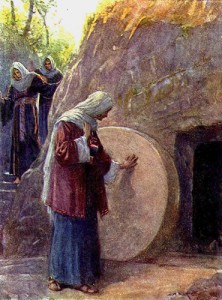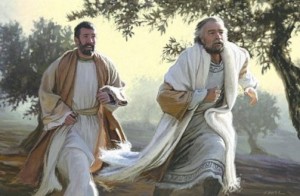Apr
21
Continuing my attempt from yesterday (actually from some years ago) to reconcile the various Gospel passages having to do with the Empty Tomb….
“I think it is worth remembering that women were second-class citizens in that culture. While Jesus (and later the disciples) taught that women were to be respected and basically treated as equals, at this point His followers were still trying to “digest” much of what He taught. It would not be surprising if they fell back into old habits during this traumatic time. This is evidenced by the fact that no one believed the women’s initial report and is one possible explanation for why Peter apparently said nothing to her on his return from the tomb.
It is also a good reason for why very few women were actually named as present during these events at & near the tomb. It is/was not unusual to leave out non-central characters when re-telling a story — all the more reason if they were “just women”. It is interesting that the angels and Jesus appeared first to women disciples rather than men. Perhaps as another reminder that “women are people, too”? I think it is significant that Mary Magdalene was the only woman named in all four accounts. She had a somewhat unique role in Jesus’ ministry both before & after His death (as seen here), and perhaps the Gospel writers couldn’t ignore that. As for why one mentions Joanna and another Salome, your guess is as good as mine. (Maybe they were related to the respective writers? Maybe they were somewhat known for telling their own eyewitness accounts?)
Matthew seems to have opted for a much compacted version of the scene(s) at the tomb. (It wasn’t the first time he did something like that.) He pretty much included the basics — angel rolled stone away, women saw the tomb was empty, angel tells them what happened and gives instructions, Jesus makes first post-resurrection appearance — and leaves it at that. Perhaps he relied on others to include further detail. Perhaps he included detail about the guards — first fainting and later reporting to chief priests & receiving bribe (v.11-15) — because no one else had.
Regarding the angel(s) involved in the first encounter, I notice that Matthew & Luke say these beings shone quite brightly (i.e., “like lightning”). It occurs to me that, if the second was very close to or perhaps behind the lead angel (i.e., presumably the one that caused the earthquake), he might have been obscured from at least some of the women’s view, or perhaps the radiance was so blinding that they only noticed one before being half-blinded. If Matthew and/or Mark read an account by one of these women or interviewed one, that would have been what went in their Gospels. On the other hand, Luke states in the opening of his Gospel that he was aware of several eyewitness accounts that had been “handed down” and that he had “investigated everything”, so it would not be surprising that he got the “full story” about there being two angels.
Again, I think Matthew telescoped the events, so that Jesus’ appearance to Mary Magdalene (and other women?) in his account actually happened after she/they visited the tomb the second time. John indicates from Jesus’ speech that M.M. clung or held onto Him. Matthew says that He greeted them and “They came to Him, clasped His feet and worshipped Him.” Perhaps when M.M. had the second angelic encounter in the tomb, the other women remained a few paces off, until they saw her talking to Jesus, and then the women joined them. Or, perhaps they were a few minutes behind M.M. and only reached the tomb about the time Jesus revealed himself to M.M.
Finally, we come to the men’s visit to the empty tomb. First, in case you aren’t aware, the disciple “whom Jesus loved” is generally recognized as the Gospel-writer John himself. I think he was the youngest of the Twelve, maybe only a teenager, which may have something to do with why Luke neglected to mention him. The fact that it was John himself is probably why he was sure to include it in detail in his own account. (What an exciting thing to experience!) While Peter’s (and perhaps John’s) confirmation of the women’s report was important, Matthew & Mark’s not mentioning it might have been because neither Jesus nor the angels appeared to them (at that time). If Matthew relied heavily on Mark as some think, or vice versa, perhaps one just followed the other’s lead on this one. But, if Mark was indeed relating Peter’s recollections, it does seem odd that he left out Peter’s part in this story.
Not being an expert in any of this, I’m sure there are other considerations that I’m not aware of. There may be another equally or more valid way to harmonize the accounts. But, that’s my best shot — for now.”
There you have it. It ain’t pretty. Not everything fits neatly together, but there are no actual contradictions. (It’s not like one writer said Peter slept all night in front of the tomb and the others said he was in town with the rest of the disciples the whole time. That would be a clear contradiction.) Nothing ad hoc, just a little reasonable speculation. A non-combative approach to these sorts of things — one that takes into account factors like cultural norms, personal vantage points of eyewitnesses, writing focus & style, etc. — allows for a logical way(s) to reconcile most (perhaps all) seeming paradoxes.

















